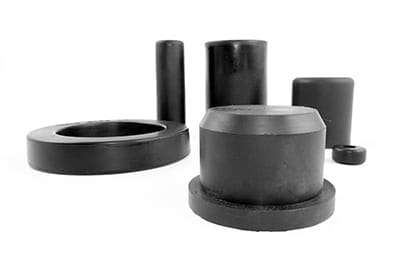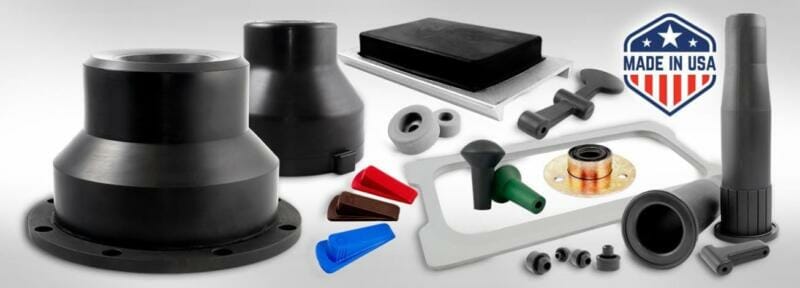Physical & Mechanical Properties / Chemical Resistance / Thermal Properties / Environmental Performance / Neoprene Rubber Applications
What is Neoprene Rubber?
Neoprene rubber, also called Polychloroprene (CR), is a durable and versatile synthetic rubber known for its outstanding resistance to oil, petroleum, and environmental factors. It provides excellent stability against UV rays, ozone, and chemicals while maintaining flexibility across various temperatures and offering superior abrasion resistance. Due to these properties, neoprene rubber is widely used in applications such as laptop sleeves, electrical insulation, automotive fan belts, and numerous industrial products.
The production of neoprene involves the free-radical polymerization of chloroprene. In commercial production, this process is carried out via free-radical emulsion polymerization, initiated with potassium persulfate. Bifunctional nucleophiles, metal oxides, and thioureas are then employed to cross-link individual polymer strands.
While natural rubber provides better mechanical properties, neoprene’s resistance to degradation surpasses both natural and synthetic rubbers. This makes it ideal for demanding applications such as gaskets, hoses, tubing, and corrosion-resistant coatings.
Advantages of Neoprene Rubber Parts
- Exceptional physical toughness
- Heat resistance
- Hydrocarbon oil resistance
- Sun, ozone and weathering resistance
- Wide temperature range for continuous use
- Superior flame retardant properties relative to hydrocarbon-based elastomers
- Resistance to twisting and flexing damage
- Versatile compounding capabilities

Properties of Neoprene Rubber
- ASTM D-2000 Classification BC, BE (Standard Classification System for Rubber Products in Automotive Applications)
- Chemical Definition: Polychloroprene
- Abbreviations: CR
Processing
- Transfer Molding
- Injection Molding
- Compression Molding
Environmental Performance
- Colorability: Fair
- Flame Resistance: Fair – Good
- Gas Permeability: Fair – Good
- Odor: Fair – Good
- Ozone Resistance: Good – Excellent
- Oxidation Resistance: Good – Excellent
- Radiation Resistance: Fair – Good
- Steam Resistance: Fair – Good
- Sunlight Resistance: Good – Excellent
- Taste Retention: Fair – Good
- Weather Resistance: Fair – Good
- Water Resistance: Fair – Good
Applications of Neoprene Rubber
Neoprene rubber is a versatile synthetic rubber often used in a wide variety of industries and applications:
- Automotive: Transmission belts, brake and steering system components, vibration mounts
- Construction: Window seals and gaskets, highway and bridge seals, washers
- Music: Speaker Cones, Piano hammer tips
- Home accessories: Laptop sleeves, remote controls, mouse pads
- Civil Engineering
- Aquatics
- Mass Transit
- Conveyer belts
- Industrial hoses
- O-rings
- Diaphragms
- Grommets
Physical & Mechanical Properties
- Durometer: 20 – 95 Shore A
- Tensile Strength: 500 – 3,000 PSI
- Elongation (Range %): 100% – 800%
- Abrasion Resistance: Very Good – Excellent
- Adhesion to Metal: Excellent
- Adhesion to Rigid Materials: Good – Excellent
- Compression Set: Poor – Good
- Flex Cracking Resistance: Good
- Impact Resistance: Good – Excellent
- Resilience & Rebound: Fair – Good
- Tear Resistance: Good – Excellent
- Vibration Dampening: Good – Excellent

Chemical Resistance
- Dilute Acids: Excellent
- Concentrated Acids: Poor
- Organic Acids (Dilute): Good – Excellent
- Organic Acids (Concentrated): Poor – Good
- Inorganic Acids: Good – Excellent
- Alcohols: Excellent
- Aldehydes: Poor – Fair
- Dilute Alkalies: Good
- Concentrated Alkalies: Poor
- Amines: Poor – Good
- Animal & Vegetable Oils: Good
- Non-Petroleum Brake Fluids: Fair
- Diester Oils: Poor
- Alkyl Phosphate Esters: Poor
- Aryl Phosphate Esters: Poor – Fair
- Ethers: Poor
- Aliphatic Hydrocarbon Fuels: Poor – Good
- Aromatic Hydrocarbon Fuels: Poor – Fair
- Extended Fuels (Oxygenated): Fair
- Halogenated Solvents: Poor
- Halogenated Hydrocarbon: Poor
- Ketones: Poor – Fair
- Lacquer Solvents: Poor
- LP Gases & Fuel Oils: Good
- Mineral Oils: Fair – Good
- Oil Resistance: Fair
- Aromatic Petroleum: Good
- Non-Aromatic Petroleum: Good
- Ammonia Refrigerant: Excellent
- Refrigerant Halofluorocarbons: R-11, R-12, R-13, R-21, R-22
- Refrigerant Halofluorocarbons with Oil: R-11, R-12, R-22
- Silicone Oil: Fair – Excellent
- Solvent Resistance: Fair
Thermal Properties
- Low Temperature Range: -70ºF – -30ºF
- Minimum for Continuous Use (Static): -80ºF
- Brittle Point: -85ºF
- High Temperature Range: +200ºF – +250ºF
- Maximum for Continuous Use (Static): +250ºF
Qualiform ISO Certified Neoprene Rubber Manufacturer
Qualiform is an ISO-certified Neoprene manufacturer offering a wide range of custom rubber molding services. We also offer capabilities in molding standard OEM replacement stars as well as custom finger lengths and configurations. If you are looking to develop a recycling star for your Neoprene application or media processing, contact our expert technical staff for consultation on design and property requirements.
As a leader in Neoprene rubber manufacturing, we offer unmatched processing, development and testing capabilities. Our services include precision rubber molding, rubber compression molding, rubber injection molding, rubber transfer molding, and rubber to metal bonding. Additionally, our experience in the industry gives us incredible problem-solving capabilities for all areas of rubber molding and rubber-to-metal bonding. As a result, we are capable of creating custom solutions for any application.
Qualiform offers 50 years of experience in rubber parts manufacturing, so customers can rely on us to create the high-quality Neoprene products they need. Contact the Qualiform technical staff at (330) 336-6777 to learn more about how we can help you.
Qualiform Proprietary Blend
Qualiform also offers a proprietary blend with reinforcing fibers for Neoprene. Our proprietary blend puts high-strength reinforcing fibers directly into the Neoprene, so the material has increased resistance against abrasions and impacts as well as improved durometer, toughness and performance. We also offer this blend for our other offered materials:
- Butyl Rubber
- EPDM Rubber
- Natural Rubber
- Nitrile Rubber
- Rigid & Flexible Rubber
- Synthetic Rubber
- Thermoplastic Elastomers (TPE)
- Viton Rubber

